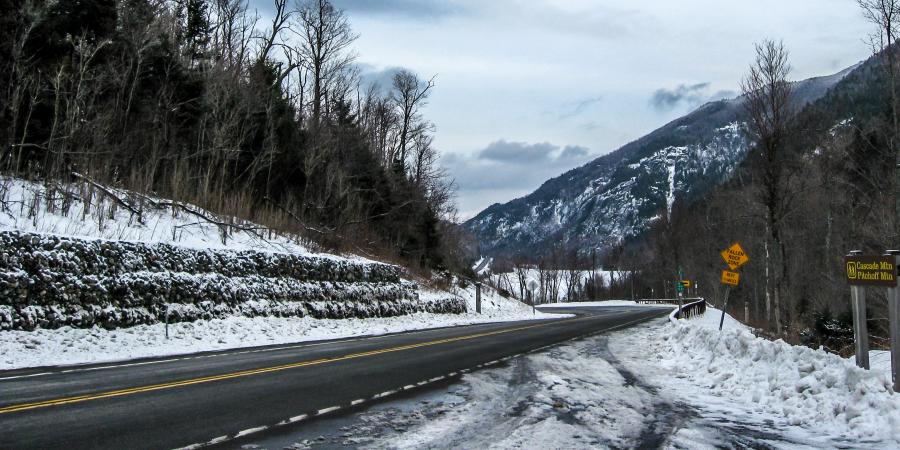Over the last several decades we've become increasingly reliant on chemical deicing agents to keep our roads clear of snow and ice during the winter season. Initially, these chemicals, primarily sodium chloride, offered what appeared to be a cheap and effective way of substantially improving the safety of our roadways. But since these chemical deicing agents rose in popularity with state and local highways departments, we've learned of many hidden costs.
The Federal Highway Administration estimates that road salt costs U.S. citizens $23.4 billion per year nationwide in investments in corrosion resistant materials, additional repairs and maintenance, and vehicle depreciation. We've also seen an increasing number of stories of road salt contaminating groundwater, causing homeowners to suffer declines in property values and additional investments in home water treatment systems. Add to these the potential for significant losses related to ecosystem services. A report issued by the Adirondack Watershed Institute in 2012, documented that the loss in these services in the Adirondack Park alone may total in the hundreds of thousands of dollars annually. Our work on Mirror Lake has related road salt pollution to declines in available lake trout habitat, an important recreational fishery.
As the years have marched on, the driving public's expectations of winter road conditions have shifted significantly as a result of an increased use of road salt, but there hasn't been a corresponding awareness of the full costs associated with its use. Conferences, working groups, and initiatives regularly acknowledge that to fully address salinization of our surface and groundwater in the Adirondacks, and elsewhere, there needs to be a shift in driver expectations and greater awareness of the hidden costs of road salt.
Below are five tips that, if we all adopted, would allow highway crews to apply less salt while maintaining safe passage on our roads during the winter.
1. Properly Maintain Your Vehicle
A worn shock or loose strut may not seem like a big deal when driving on dry pavement, but they can make a huge difference when dealing with slippery winter roads. The same goes for good brakes and properly functioning traction control systems. As winter conditions approach, consider bringing your vehicle into a local shop to have it serviced. Investing a few dollars in maintaining your vehicle may make the difference between safely completing your morning commute or ending up off the side of the road.
2. Use Snow Tires
While it may be tempting to stick with your all-season tires through the winter season, they aren't designed to deal with the snow and ice commonly found on roads in northern New York. Snow tires not only have a more aggressive lug pattern, and they are made of softer rubber to help maintain traction on icy roads. A braking test conducted by Edmonds.com found that in snowy conditions winter tires resulted in breaking distances 66% shorter than summer tires and 17% shorter than all-season tires. This may sound not sound like a huge distance between winter and all-season tires, but it's a 32-foot difference in braking distance for a small sedan traveling at 40 mph. And while the cost of purchasing snow tires may seem hard to justify, you'll be thankful when they help you safely navigate winter conditions and you'll extend the life of your summer or all-season tires.
Support our water quality work for clean water and healthy streams in the Ausable River watershed. Give with confidence today!
3. Carry An Emergency Kit
In the event that you do get stuck on the side of the road, or are stopped by white-out conditions, you'll want to be prepared. The following is a list of items that can fit into a small rubber tote and may prevent a bad day from becoming worse.
Winter safety kit: shovel, windshield scraper, flashlight with extra batteries, water, food, matches and small candle, extra clothes (hat, mittens, scarf), sleeping bag or blanket, first-aid kit, necessary medications, tow rope, sand or cat litter for traction, jumper cables, emergency flares, cell phone charger.
Also, try to keep your gas tank at least half-full during the winter months. The added weight of the gasoline will help with traction, while also buying you extra time if you need to idle your car to stay warm.
4. Slow Down And Keep A Safe Distance
Even with a properly maintained vehicle and snow tires, there will be times when road conditions require you to slow down. When the roads are covered with snow or ice, give yourself extra travel time to make it to your destination and keep a greater distance from vehicles in front of you. Remember, even with snow tires on, braking distances are farther on snowy pavement than dry pavement. Traveling at slower speeds will help you maintain traction and control of your vehicle.
5. Check The Weather
Finally, before heading out check your local weather forecast. If conditions are really bad, consider changing your plans or giving yourself extra travel time. Knowing the conditions before heading out while allowing you to develop better travel plans. And if you do need to head out in a big snowstorm, make sure to let someone know your travel route and expected time of arrival. If you don't show up, they'll know where to direct rescue personnel to look for you.
Remember, our current expectations for winter road conditions rely on very high application rates of road salt which costs us in corroded infrastructure and vehicles, as well as polluted surface and groundwater. If we all follow the tips above our highway crews can put down a little less salt, and we can remain safe. It's one small piece of the puzzle in striking a better balance between winter road maintenance and protection of the environment.
Sign-up for our e-newsletter to get weekly updates on the latest stories from the Ausable River Association.





